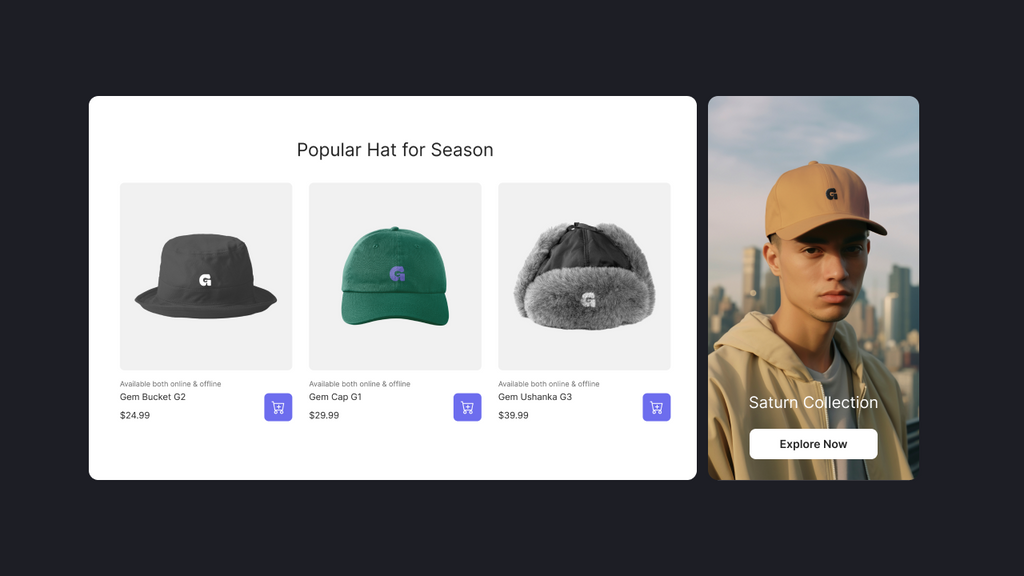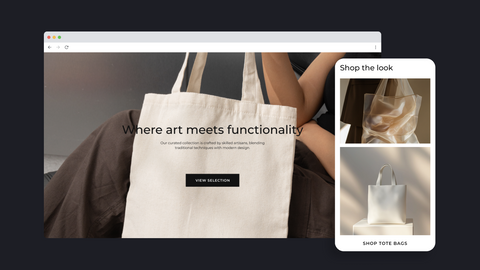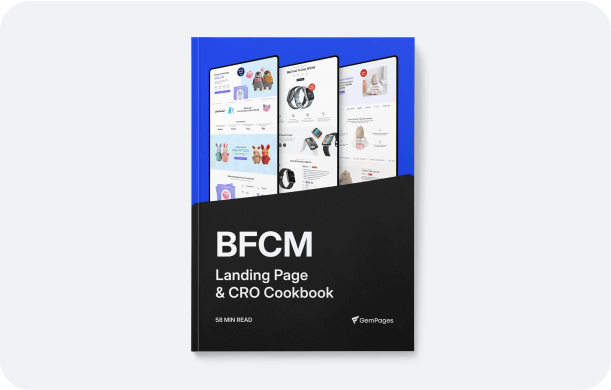How To Start A Hat Business: All You Need To Know To Build A Thriving Brand

Hats are a must-have item in daily outfits for countless people, thanks to both their convenience and fashion. Have you ever dreamed of your own hat business? With the headwear market booming and varied business models, there’s no better time to turn that dream into reality.
Our blog today will clarify how to start a hat business in 6 steps, which can be flexibly used for any hat ideas, from classic baseball caps to trendy bucket hats. Right now, let’s dive in!
Why Is A Hat Business Worth The Investment?
Before starting or planning anything about your hat business, it’s important to understand its market—we would like to say the headwear market, including hats, caps, and beanies.
In the Global Headwear Growth Analysis Report (2024 - 2032), the headwear market was valued at USD 30,319.96 million in 2024, with a growth in demand for both style and protection. Notably, headwear now caters to various styles, from casual to formal, which can be found in both online and offline sales channels. That’s why starting a business with casual hats is still a promising niche with significant potential for long-term growth and profits for startups.

The global headwear market is by segment from 2024 to 2032
“Asia Pacific dominated the market with a revenue share of 40.5% in 2022”, highlights Grand View Research. However, the environmental conditions in the winter in European countries like Finland or Sweden are expected to kick off considerable growth of hats in the coming years. Otherwise, South Asian residents prefer hats as a style statement, especially among the GenZ.
In short, to succeed in this thriving niche, you need to have an in-depth understanding of market trends and customer preferences. This helps you tailor your designs to resonate with specific demographics and regions, effectively positioning your brand in a competitive industry.
How Much Does It Cost To Start A Hat Business?
Always take care of various costs to have the best preparation for your hat business operation. A hat store often charges you from $1,000 to $10,000, depending on your models and scale:
1 - Low-cost (Print-On-Demand)
-
Initial Setup (e.g., website, design software, legal fees): $800–$1,500
-
Branding and Marketing (upfront): $300–$1,000
-
Operational Costs (e.g., platform fees, shipping, and packaging): $100–$500/month
-
Total: $1,000–$3,000
2 - Mid-Range (Stocking Inventory)
-
Inventory Costs: $2,000–$5,000
-
Branding and Marketing (upfront): $500–$2,500
-
Operational Costs (e.g., storage, shipping): $200–$1,000/month
-
Total: $5,000–$10,000
3 - High-Cost (Full-Scale Production)
-
Production Setup (e.g., materials, machinery): $5,000–$10,000
-
Marketing and Branding (upfront): $2,000–$5,000
-
Operational Costs (e.g., storage, shipping): $500–$2,000/month
-
Total: $10,000–$20,000+
|
Note: The cost range above can be flexibly modified depending on factors like inventory size, product scale, marketing strategy, and operational efficiency. Therefore, you can feel comfortable and confident whether your budget seems lower or higher than these numbers. |
Which Are The Best Hat Ideas To Design and Sell?
Now that you’ve clarified “How much does it cost to start a hat business?”, it’s time to discover trendy, profitable hat ideas to level up your business sales in the eCommerce market.
Timeless Vintage Revival
Vintage-inspired hats are making a strong comeback in the modern world, engaging customers with a sense of nostalgia and a desire for unique fashion statements. You can start with porkpie hats, with their narrow brims and structured crowns, and then add a distinctive retro flair. Don’t forget to take advantage of classic materials like velvet or felt to boost the authentic vintage feel.

Vintage hats feature 2000’s fashion styles with impressive color palettes
In addition, focus on color schemes that reflect the spirit of vintage fashion, like deep burgundies, mustard yellows, and classic neutrals. They’re truly not as cheesy as you might think; instead, keep everything not overly bold and harmonized with your overall design.
Chic Minimalist Lines
If your hat business targets consumers who prefer subtlety over extravagance, minimalism should be considered. In fact, hats with simple geometric patterns or monochromatic palettes can match various outfits, making them practical choices for everyday wear. Be mindful of using high-quality materials to ensure durability and comfort, enhancing the overall appeal over time.

Chic minimalist lines make your hat designs unique and impressive
Eye-Catching Embroidery
In a world filled with mass-produced, cookie-cutter accessories, embroidery offers a chance to stand out with something truly special. That’s why we mention embroidered hats here as a personal touch to speak to quality, authenticity, and individuality.
If so, what should you do with this hat idea? It’s the texture. The raised threads might catch the light, add depth and interest, and finally turn heads with every wear. You should also offer customers the chance to add their initials, a meaningful quote, or any of their custom designs. Trust us: personalization is crucial to make your brand stand out in today’s world of fast fashion.

A hat business sells hats with embroidery images inspired by animals
But it’s not just about the design—it’s about the well-executed craftsmanship. It is a mark of durability, attention to detail, and careful artistry, which effectively maintains customer loyalty.
Trendy Patchwork Fusion
Patchwork hats blend various fabrics and patterns, resulting in bold, eclectic hats that stand out. With individuals with strong statements, this idea truly attracts them and drives much interest. Notably, all patchwork designs are all about contrasting textures. Mixing materials like denim, tweed, and cotton or combining prints like plaids or florals creates a visually stunning interplay.

Patchwork hats have become a phenomenon in the hat industry
What’s more interesting? Patchwork hats are tailored to eco-conscious consumers. They often incorporate uncycled or leftover materials, which is a win for the planet and your brand’s sustainability credentials. Truly, it is a great idea to market your brand in the early days.
Culture and Tradition
Everyone cherishes their roots—be it their country, traditions, culture, or religion. Therefore, incorporating traditional patterns, weaving techniques, and symbolic colors can attract customers at first glance, especially those with an interest in culturally meaningful fashion.
However, it’s important to have an in-depth understanding of these cultural backgrounds to avoid misrepresentation or cultural appropriation. You should partner with artisans or local communities and honor the significance behind the elements you incorporate into your hats. This can help build authenticity and foster trust, as well as appreciation among your customers.
How To Start A Hat Business With 6 Steps
Here is our step-by-step guide to help you perform the best sales with a hat business.
Step 1: Have your market research
First and foremost, you need to understand your target audience or define who you’re selling to:
-
Millennials look for unique, personalized hats
-
Gen Z loves up-to-date trends
-
Outdoor enthusiasts need functional hats for protection
-
Sports fans want branding or team merchandise
Next, let’s use varied methods like surveys, social media listening, online communities, or competitor analysis to collect as much insight about your audience as possible. This is especially effective in ensuring your designs satisfy their preferences and expectations.

Sellers can have a deeper understanding of customer insights through social media
But not just for your audience, you should keep an eye on the latest hat industry trends to stay ahead in such a competitive eCommerce market. Sustainability, customization, retro styles, or athleisure might be “trendy terms” that you can use to inspire your product lines. Don’t forget to clarify your USP from the first days to differentiate your brand from the competition.
Step 2: Build a detailed business plan
Your business plan for a hat store, whether small or large, should be clear and well-structured. This plays a role as a magnetic needle to follow from day one to long-term success.
Set Measurable Objectives
It’s time to discuss your objectives! Maybe you’re selling 1,000 hats in your first year, partnering with five local boutiques, or growing your Instagram following to 10,000 engaged fans. All of these specific numbers will keep you motivated and serve as your measuring stick for progress. Whatever goals you have should be measurable and estimated, not too vague!
Define Your Signature Hat Styles
The next thing is to define your signature hat styles to stand out in your brand’s identity. However, start small; prioritize one or two styles to perfect your production and branding. Once you’ve built momentum for your hat business, expand your product range strategically.

FairFax & Favor defines one signature hat style with three classic colors
Budget Wisely
Don’t forget that budget is like a pro—money talk, but it can also disappear fast without a plan. You should break down your costs into the 4 typical categories: production, logistics, marketing, and miscellaneous, which are also the key activities you should focus on during your operation. That’s why your business performance always comes together with your finances!
Estimate competitive pricing
Once you know your in-reality expenses, determine your pricing with a simple formula:
(Cost/ Hat+ Profit Margin) = Selling Price/ Hat
For example, if your production cost is $15 per hat and you aim for a 30% profit margin, your selling price would be $19.5. There will not be an exact number for your profit margin, normally from 30% to 50%; thus, you can benchmark against similar products to validate your pricing.
Step 3: Select your business model
Deciding on your hat business model depends on your goals, budget, and how much control you want over production and branding. Below are the 3 top options to consider:
Print on Demand (POD)
Imagine running your hat store without the need for inventory, warehousing, or even upfront costs but ensure personalization and creativity. That’s the magic of what is print on demand (POD), a business model designed for sellers who want simplicity, flexibility, and low risk.
With POD, you upload your hat designs to a supplier platform (e.g., Printify or Printiful), and they help handle everything else—printing, packaging, and shipping—each time you make a sale. Notably, you can empower your customers to express their high self-esteem with quirky slogans, minimalist patterns, or bold statements. It’s the ultimate win-win.

Printify offers various POD services to complete your hat designs
Dropshipping
When an order is placed, your supplier will directly ship the product to your customers. Thus, you don’t need to control product inventory or worry about overstocking. This makes it beneficial for beginners who want to enter the market without a high upfront cost. However, you’ll have limited control over shipping times, branding, design, and product quality.
In-house Production
Unlike POD and dropshipping, in-house production gives you full control over your brand. You’ll design, produce, and even package your hats on your own. This surely requires careful planning, powerful tools, high upfront costs, and a skilled team to perform the best results.
Step 4: Develop your hat designs
Once you’ve finalized a solid hat idea, the next step is to bring it to life with striking and memorable designs. These will tell your story, captivate your audience, and set you apart!
You should start by brainstorming visuals that align with your brand identity and customer preferences (just in case you’re running a POD hat business). Then, select patterns, colors, fonts, and graphics to easily catch visitors’ eyes and level your final products.

Picasso Multimedia instructs how to design a hat with Adobe Illustrator
After that, select a proper platform to optimize your design. While Canva offers beginner-friendly tools with customizable templates, Adobe Illustrator provides advanced options for intricate designs. Otherwise, you can hire freelancers—those you can easily find on Upwork or Fiver.
Once your designs are ready, production methods like embroidery, screen printing, or digital printing can significantly affect the final look. This is especially important to POD businesses, where the product stage belongs to the POD fulfillment partners. Keep in mind that samples should be requested to review the quality and make any necessary tweaks.
Step 5: Set up your hat online store
You can sell hats on marketplaces, eCommerce platforms, physical stores, or pop-up events. However, if you only want to sell online but have a dedicated store that gives you full control over your brand, customer experience, and profits, think about eCommerce platforms.
Currently, Shopify stands out as the most popular choice for building eCommerce stores. It offers an easy-to-use interface, powerful customization options, and various features to streamline your hat business operation. You can easily manage inventory, process payments, and integrate with third-party apps like POD or marketing to optimize your brand venture.

GemPages helps sellers build well-structured, high-conversion websites
You can also install leading landing page builders like GemPages to simplify your store setup in minutes. With 200+ CRO templates and numerous custom options, GemPages allows you to create professional and visually appealing pages without coding expertise. It’s also accessible directly from the Shopify Admin, allowing you to build and refine your store efficiently.
Step 6: Run promotions for your hat brand
A great hat doesn’t sell itself—you need to get it in front of your audience. In the early days, start by crafting irresistible offers like limited-time discounts, bundle deals, or “buy one, gift one” campaigns to spark urgency and excitement. After that, you should utilize social media, SEO, and influencer marketing to drive organic traffic to your website and kick off your sales.

Email marketing tools can help simplify your hat business’ email marketing strategies
Don’t ignore email marketing or think it is outdated today. A well-timed email with a catchy subject line—like “Top Off Your Style This Season!”—can reel in repeat buyers. Pair it with social media and Google Ad campaigns to keep your brand at the top of their minds.
Conclusion
All in all, starting a hat business is not a challenge if you have a well-structured business plan. Besides that, be aware of your budget and your target market to have proper backups and minimize the risks during your business operation, especially for startups or small brands. Finally, keep updated with the trends to make your hat brand stand out in the market.
Check out GemPages blogs to learn more tips and tutorials about eCommerce and business!



 Facebook Community
Facebook Community Change Log
Change Log Help Center
Help Center












